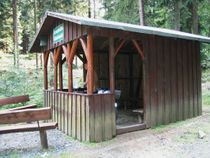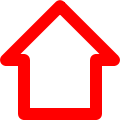Proposal talk:Wilderness mountain buildings
|
Please discuss topics related to a special proposal on its own discussion page. Talk:Proposed_features/Alpine_hut Talk:Proposed_features/Wilderness_hut Talk:Proposed_features/Basic_hut Talk:Proposed_features/Lean_to |
Serviced huts in lowlands?
Why does the alpine_hut definition limit it to mountains only? Whereas wilderness_hut doesn't have this requirement ("isolated" only, which makes sense).
IMO it makes a category of serviced manned huts located in lowlands not covered at all. I.e. there are "Great Walk" (and "Serviced") huts in New Zealand with a ranger/caretaker present (but one has to bring his/her own food which is common in all NZ huts) and located at sea level. --Pastk (talk) 13:40, 31 March 2024 (UTC)
norway alpine_hut case
The current descriptions do not allow all combinations; in Norway (possibly also Sweden and Finland), there are alpine huts that do not have permanent staff, but where you still have to pay to sleep and have the possibility to buy food and prepare it yourself. Some of these have staff in season, but are usually open all/most of the year without staff. Therefore, the tourism=alpine_hut should not require permanent staff (though it may well be considered the default), which is also in accordance with the wikipedia article. -- Einarr 13:58, 3 August 2009 (UTC)
- The problem is that the only way to make distinction between alpine_hut and wilderness hut, is staff or no staff. Maybe what you are discribing is wilderness_hut + food=yes +fee=yes
- Could you explain how it works so we could find the best way to take it into account :
- how do you pay for it ? payment in advance ?
- how do you get food is there is no staff ? free cupboard access and leave a money ?
Sletuffe 14:11, 3 August 2009 (UTC)
- You pay both your stay and the food by putting money or a credit card payment form in an envelope and dropping them in a safe on the hut. Yes, you have free cupboard access, so the system is based on trust. To get access in the first place you'll have to pick up a key (which is the same for most (all?) of the network of alpine huts run by the Norwegian mountain touring association). As the key is the same for all huts, there is no other way than the trust-based system to tell where you've been and how long you stayed.
- My point was also partly that some alpine/wilderness huts are run by staff only in season, meaning summer/autumn and perhaps easter. The rest of the year it is open using the system described above (with or without available food). It would therefore change between alpine_hut and wilderness_hut depending on the time of year, which I think may be the real representational problem here.
- I'm not sure which way this could best be described. Perhaps by leaving these as alpine_hut and adding some extra tags for the off-season service level. However, these tags should preferably be the same as for the wilderness huts.
- Also, I'd like someone from Sweden, Finland, Austria and Switzerland to say something about how their systems fit into the scheme. Anyone from these (and other countries that have such huts) reading this?
- -- Einarr 17:21, 3 August 2009 (UTC)
- Your proposition looks relevant setting staff=no to an alpine_hut might do. (Or food=yes to a wilderness_hut ;-) ) Sletuffe 22:06, 3 August 2009 (UTC)
- Here from France, it's quite ok with this scheme, same for switzerland (to my few knowledge) and a few variation might be handled with optionnal tags Sletuffe 22:06, 3 August 2009 (UTC)
- Mmmm, the idea behind staff=no (only off seasons) is really what I consider to be an alpine_hut. The case exist in france, and I would surely tag it as alpine_hut without staff=no as it is not permanently true. However, the case there is an open part off season is the problematic case :
- Either it is a different part of the building, so a different location, in that case one other point wilderness_hut could do (with a opening_hours saying it's close in season
- If it really is the same rooms as the alpine_hut, I see two solutions : we superpose two points (one alpine_hut one wilderness_hut at the exact same location) or we add optional tags to alpine_hut such as open_off_season=yes+food=yes/no
- I'd like to have a better way, but have no idea Sletuffe 11:43, 5 August 2009 (UTC)
- The New Zealand system sounds very similar to Norway but with no food available you have to bring that yourself -- gerkin
- Mmmm, the idea behind staff=no (only off seasons) is really what I consider to be an alpine_hut. The case exist in france, and I would surely tag it as alpine_hut without staff=no as it is not permanently true. However, the case there is an open part off season is the problematic case :
Mountain Huts in the UK
In the UK there are quite a number of mountain huts, but most are owned by various Climbing Clubs, and do not provide access to the general public. Many of these facilities are old farm buildings with separate dormitories for men and women, a communal kitchen and social area. They do not have any staff, the custodian being a volunteer, who monitors the hut condition and administers bookings. The main organisations which own such buildings are: the British Mountaineering Club, Scottish Mountaineering Club, Fell and Rock, Midland Mountaineering Club, Pinnacle Club, Climbers' Club. Many universities also own similar accommodation, again available only to associated individuals. Historically, these huts were not liable for certain taxes or required to adhere with legislation relating to accommodation for hire. Although now classed as businesses the status of these places as members only has remained. The long-established clubs do have reciprocal arrangements under the 'Kindred Clubs' scheme.
Thus these places cannot legitimately be tagged with tourism=*, but are entirely Alpine Huts. Several are in prominent locations in wilderness areas, the most notable being the SMC CIC hut under Ben Nevis. Others are well known, such as Helyg and the BMC hut at Glenbrittle.
At the moment there is no convenient means of tagging these places consistently. This proposal is highly appropriate. I believe the tagging scheme should take local distinctions such as these into consideration. SK53 15:18, 3 August 2009 (UTC)
- I was a bit worried too with tourism, but as alpine_hut is almost already approved as tourism, I felt that keeping on this line was the least problematic way. amenity category was the other option, but to be honnest, I consider them as secondary as it's just a categorie system wich allready as low meaning.
- as of the country specific things, either create a tag such as uk_legislation=yes, or best, don't do anything and explicit on the wiki that any uk widerness_hut has this default properties. (or if it's dependent of club owner, use the tag operator as suggested wich will trigger knowledge about them) Sletuffe 15:34, 3 August 2009 (UTC)
- Tourism should not be used for buildings that are not open to the public. The tourism tag is likely to be used by many applications to generate POIs for tourists, and should not include stuff that tourists do not have access to. I would prefer (by far) another main tag for private club/company/university/organization cabins, but keeping the exact same sub-tagging for toilets/mattresses/drinking water/ etc. Perhaps by using a tourism:private=alpine_hut tag, so that the link is obvious to anyone.Einarr 14:22, 23 August 2009 (UTC)
- The issue is also present in Norway. If these are marked with as tourism, there should at least be a private=yes and an operator= tag on them so that they are easy to filter in/out for different purposes. I support the idea of taking everything out of the tourism category, but I'm not sure what to use instead. A new "top-level" tag like hiking=, backcountry=, mountaineering= or something similar might be better. -- Einarr 17:44, 3 August 2009 (UTC)
- The idea of a main tag was proposed in Proposed_features/Shelter it was called refuge= with different possible values. I think it's basically the same result, but would break the already quite used tourism=alpine_hut Sletuffe 22:09, 3 August 2009 (UTC)
Too complicated
With local knowledge, the name of the structure gives you a clue what to expect: a bivacco is a bivacco, a bothy is a bothy, nothing to add.
Just two categories are enough
Bivvy = basic man-made or natural structure, to provide a resting place for climber, fisher or hunter. You basically have to bring everything you need (food, cooking device and sleeping bag). Hut = Full confort. You basically bring nothing but a big wallet (refuge (FR), cabanne (CH), Hütte (D,A,CH), rifugio (I), hija (BG). In western Europe the distinction between a "mountain hut" and an "hotel" is quickly vanishing. Do not use Alpine_hut as the Alps are not the only mountains.
Is it open, how to get in ? opened=* possible value always|staffed_period|key|membership
Is ist staffed ? staffed=*, possible values always|never|season
If yes, when ? staffed_period=* values spring,sommer|february-october
What to expect ? Some feature may be only available when staffed
cooking=* possible values wood|gas|coal|petroleum|electric|staffed_period|no food=* values yes|no|staffed_period
blanket=* values yes|no|staffed_period
reservation=* values yes|no
fee=* values yes|no
etc. --Gummibaerli 16:56, 22 August 2009 (UTC)
Well I do agree a bit with you. We had too many categories, but two looks too small to me, where do you put this
?
Not a hut, neither a bivvy.
As of your sentence With local knowledge, the name of the structure gives you a clue what to expect: a bivacco is a bivacco, a bothy is a bothy, nothing to add. I do not agree, both have no meaning in French. Or do you mean you want to place the local name somewhere ? like name="bothy of the queen" or another tag : loc_type="bothy" ? sletuffe 16:16, 12 October 2009 (UTC)
"bivacco, a bothy" have no meaning in NZ and we have a network of well over 900 wilderness huts so I agree with Sletuffe on this one. The four proposed OSM features will cover most structures/shelter types I think -- gerkin 28 Oct 2009
New Zealand incompatibility
I moved out this note for discussion : * NOTE: most of the characteristics listed above are not relevant to New Zealand Alpine huts, See: [1] -- gerkin
- As I read it, the link you provided doesn't describe an alpine hut in the "osm described sense" but it might be better tagged with tourism=wilderness_hut. + fee=yes
- The problem of course (as mentioned somewhere else I don't remember) is that definition vary from country to country. And because I think tourism=alpine_(french/italian/new_zealand)_hut is not a good idea, I propose we stick to one osm definition. And maybe the scale of new zealand huts might be constructed as follow :
- Serviced Alpine Huts = wilderness_hut + fee=yes + operator=*
- Basic Huts = lean_to
- Great Walk Huts = wilderness_hut + fee=yes + quality= ?
- Serviced Huts = wilderness_hut + fee=yes + access=?
- *NOTE: I wouldn't take too much notice of these four categories above (from the NZ DOC site) as they do not really refer to a structure type but are really more administrative and refer to booking, availability, fees charged and so forth --gerkin 26 Oct 09
- Sure, this mapping is not optimal, and if really needed, a new tag new_zealand_hut=Great Walk Huts could be added. But, it looks impossible to have an osm scale that have a direct equivalent in every country. sletuffe 15:50, 12 October 2009 (UTC)
- *NOTE: I don't think there is any need for a special "new_zealand_hut=Great Walk Huts" tag the proposed description tags will cover this -- gerkin 26 Oct 09
- The four proposed features: Alpine_Hut, Wilderness_Hut, Basic_Hut & Lean_to look like a reasonable compromise to me.
- The description tags should clear up any questions ie. wardens, facilities, fees etc. I agree that we should stick to one OSM definition if possible.
- *NOTE: Nearly all NZ back-country huts will be fee=yes; even the "Basic_Hut" (also the "serviced" referred to above does not mean serviced in the hotel or tourism=alpine_(french/italian sense) -- gerkin 26 Oct 09
Keep it generic
As it stands, this proposal seems to make a lot of assumptions that just don't hold up internationally. I can see value in three categories:
- Serviced hut: you will find staff and food. (But probably not bedding, that's just a hotel)
- Basic hut: you will not find food there.
- Shelter: Not necessarily even sealed against the elements, you could camp inside in an emergency.
Assumptions like fireplaces don't work in Australia (all forms of fire are being phased out in national parks). Terms like "wilderness hut" don't work because then the identical same hut in a non-wilderness location becomes awkward to tag. "mountain hut"/"alpine hut" doesn't work for the same reason, there's no real requirement for mountains.
Also, whether or not you can reserve in advance will depend very much on the local situation. That's not a good requirement for a hut tag. (In my experience, even huts that "require reservation" will let you sleep on the floor if it's too late to reach the next hut before dark.)
A useful extra tag will indicate whether it's public or private. (For example, in Tasmania, there are private huts used by commercial hiking operators - you can only use them if you're part of an organised group.) Stevage 11:29, 20 February 2010 (UTC)
Generic loses meaning
as commented on the Proposed features/Shelter page:
- The definition of a bivouac in New Zealand (where there is an extensive alpine and back country hut network, and many officially mapped (life-saving) bivouacs) is: "An emergency shelter, place known to offer protection in remote areas, maybe either natural as in the cleft of a rock, or the lee of a fallen tree etc, or man made." As it's not necessarily a building, man_made, natural, or for leisure/tourism.
- I'd consider amenity=emergency_shelter for it but I'd worry that would quickly get confused with large bomb/hurricane/homeless/domestic violence shelters for large numbers of people in cities.
- tourism=Proposed_features/bothy is similar but it is more like a standard back country hut here (with fireplace and windows, walls, and other nice things to have when cold and wet).
- So what's the french meaning? Any tent in the wilderness? does it make sense & are they likely to map those?
- amenity=bivouac + construction=rock + fireplace=yes|no + flavour=nz|fr :-)
- How about amenity=shelter + shelter=wilderness_grade1-wilderness_grade5 (+ photos of each grade) getting more rustic as you go? grade1 has double glazed windows and a warden, grade5 is a rock overhang for emergencies.
- grade1
- your bed is made for you; cappuccino machine and electricity; etc. Basically a hotel that you have to hike to. (=chalet?)
- grade2
- maybe staffed by a warden; maybe windows that open and close; maybe has gas cookers and a solar powered composting toilet; maybe nicer than your flat in town
- grade3
- standard New Zealand hut. tidy; maybe a cast iron wood burning stove; usually a long drop toilet outside in good repair; windows and doors that work; it's fun to stay here
- grade4
- 4 walls and a roof but not much more; possibly once a grade3 but now in a bad state of repair; generally has a door, but maybe it is just a sheet of corrugated metal with a bit of wood to jam it shut; may have a fireplace if you are lucky; maybe a smelly unserviced long drop toilet outside if you are lucky (probably without a real door); somewhere to sleep and get out of the weather (mostly), but generally not very comfortable
- grade5
- A-frame emergency shelter with room to lie in and sit up but not much more; may have 1 or more man made walls, probably no fireplace; lean_to; rock bivvy
- see also: NZ Hut Gallery
- --Hamish 12:33, 13 April 2010 (UTC)
- What you are proposing is not that far from what is in the proposal. You propose one more level but it's much like replacing words by gradeX
- grade1 & grade2 looks like an alpine_hut, grade3 is wilderness_hut, grade4 is basic_hut and grade5 realy looks a lean_to.
- Well, since a few problem raised are about "words", then using numbers could do as well. I have no opinions, either one or the other. (ok my comment is a bit useless, but It's to show I still have interest in this proposition) sletuffe 21:04, 15 April 2010 (UTC)
- -- Correct, they are almost the same but I would be less strict about the unbolded has/has not recommendations in the classes (e.g. unmanned wilderness huts may want a $5 hut fee ticket/sticker and may not have a fireplace); and I would avoid merging your basic_hut class with wilderness_hut -- see the difference in my grade3,4 definitions. The idea would be to follow a similar scheme as highway=track + tracktype=* uses. (grading being just a 2c idea for your consideration :) --Hamish 09:03, 5 May 2010 (UTC)
construction
The Tag construction=* does not describe the material or origin of a feature. --Zuse 09:02, 4 April 2012 (BST)
moving to a vote ?
This proposal has had no changes since 1 year and we might ask for a larger feedback by casting a vote. (the rfc has allready been sent to the tagging list more than one year ago). Does anyone mind if I sent an email to cast for a vote on the tagging list ? sletuffe 13:32, 4 April 2012 (BST)
- I suggest to send out a new RFC (Request For Comments) first. Later you can cast for a vote for all four proposed tags at the same time. I think a voting for this group as whole is difficult. Before requesting a vote, we need a clean-up of all four tags. For example there are some additional tags that don't refer to each proposal. We should also copy some points of the discussion to the appropriate proposal.--Rudolf 14:26, 4 April 2012 (BST)
- I see you are doing lots of clean up, I'll wait for that before sending an rfc request sletuffe 14:40, 4 April 2012 (BST)
- That's right, but please look at the pages yourself. Perhaps you can copy some points of the discussion.--Rudolf 16:42, 4 April 2012 (BST)
- Hi Sly. Please take a look at the four proposal pages. If you think it's okay, you can start a new RFC for each.--Rudolf 22:47, 4 April 2012 (BST)
- Done sletuffe 14:06, 5 April 2012 (BST)
- I see you are doing lots of clean up, I'll wait for that before sending an rfc request sletuffe 14:40, 4 April 2012 (BST)
Reservation should not make it an alpine hut...
Reservation should be a describing key, but not one that defines that a small hut becomes an alpine hut. E.g. in New Zealand there are very small to mid size (like 5-20 dorm beds) huts, that you can reserve at the forest/park authorites. In emergency you can also arrive without reservation. You pay a small charge for sleeping, firewood/coal and so on, but there is no one who provides services, there is also no food available,..... Just because you need a reservation doesn't say anything. I therefore removed Reservation from wilderness_hut...--Extremecarver 21:50, 4 April 2012 (BST)
- I approve this.--Rudolf 09:28, 5 April 2012 (BST)
- +1 to this. But I can't remember why it was added and who found it usefull. sletuffe 14:07, 5 April 2012 (BST)
- I approve that an additional reservation=* don't define an alpine hut. But after some afterthoughts I suggest to keep the additional tag also for wilderness_huts, eg for huts in New Zealand.--Rudolf 12:46, 15 April 2012 (BST)
- +1 to this. But I can't remember why it was added and who found it usefull. sletuffe 14:07, 5 April 2012 (BST)
Additional tag staff=no/yes/season
This tag was suggested for special cases where an alpine_hut is just like the description, but not a wilderness_hut because it provides food, but still, it has no human presence.
IMHO we don't need this tag. In alpine_huts there is staff during the opening dates. Outside the opening period there is no staff. In wilderness_huts, basic_huts, lean_tos there is no staff. In special cases a wilderness_hut can provide food, but this don't change it to a alpin_hut.--Rudolf 09:25, 5 April 2012 (BST)
- +1 to this as well sletuffe 14:08, 5 April 2012 (BST)
Rendering (proposal)
I searched some hiking maps for map icons.
Here is an example from IGN maps: 
The refuges are normally displayed in red color. The same color is used in Alpenvereinskarten and Kompasskarten. So I created some icons according to this hiking maps. Only the icon for lean_to is a new creation. It shows a flat roof. Perhaps we can use a flat roof also for basic_huts.
- Icons according to hiking maps, 20 x 20 px
Openstreetmap suggests blue color for key:tourism and brown color for key:amenity. So I changed the color according to osm.
- Icons according to hiking maps, colors from osm, 16 x 16 px
Other proposals:
Alpine_hut: ![]() (up to date icon in mapnik)
(up to date icon in mapnik)
Wilderness_hut: ![]()
Basic_hut: ![]()
Lean_to: ![]() or
or ![]() or
or ![]()
Shelter: ![]() (up to date icon in mapnik)
(up to date icon in mapnik)
Any comments are welcome.--Rudolf 21:23, 10 April 2012 (BST)
Here comes another suggestion with some pictograms.
- Icons, with pictogram, colors from osm, 32 x 32 px
Original size: ![]()
![]()
![]()
![]()
![]() --Rudolf 14:08, 19 April 2012 (BST)
--Rudolf 14:08, 19 April 2012 (BST)
Additional tags to discribe the equipment
I suggest to move the additional tags to the refering proposal pages. Not every additional tag match to all proposals. The summary page should display an overwiew of the four proposals. It mustn't show the additional tags. --Rudolf 22:49, 12 April 2012 (BST)
Isolated pre-requist
What do you think about the new wording that must be valid for every 4 proposal about the isolated nature :
All share the same property : They are isolated, ie public access for motorized vehicles is forbiden or impossible. Optional owner access through restricted tracks or helicopter might still be possible. sletuffe 18:02, 19 April 2012 (BST)
- The notation is okay. Perhaps you can use characteristic instead of property. One typo: forbidden. --Rudolf 22:47, 19 April 2012 (BST)














